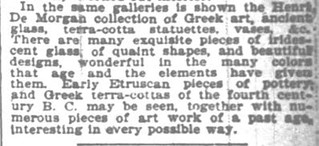
PREV ARTICLE
NEXT ARTICLE
FULL ISSUE
PREV FULL ISSUE
HENRI DE MORGAN (1854-1909)John Lupia submitted the following information from the online draft of his book of numismatic biographies for this week's installment of his series. Thanks! As always, this is
an excerpt with the full article and bibliography available online. This week's subject is archaeologist and coin dealer Henri de Morgan. -Editor
Henri de Morgan was an archaeologist, numismatist and coin dealer who also catalogued for several auctions in New York City where he kept a shop. He was an expert in French medieval, Greek, Persian, and Egyptian antiquities. In New York he was an associate of Thomas Benedict Clarke (1848-1931). In the winter months of 1906 through 1908 he directed excavations of prehistoric, i.e., predynastic sites in Upper Egypt between Esneh and Edfu for the Brooklyn Institute Museum. The objects he excavated and collected were divided between three disparate museum collections : the Brooklyn Museum, the Musée des Antiquités Nationales in Saint-Germain-en-Laye in Paris, and the Egyptian Museum in Cairo. He is the elder brother of Jacques Jean-Marie de Morgan (1857-1924), Director of the Department of Antiquities in Egypt (1892-1897), also a very well-known archaeologist who discovered the Stele of Hammurabi now in the Louvre Museum, Paris, France. Henri de Morgan (1854-1909), was born at Huisseau, sur, Cossonay, Cher, Centre, France, son of Eugène de Morgan (1829-) and Louise Marie Caroline Henrietta de Calonne d'Avesnes de Morgan (1832-1864). He and his younger brother Jacques were students of antiquities at l'Ecole des mines de Paris, studying mining engineering in the footsteps of their father. In 1872, a teenager of eighteen, he and his younger brother became associated with French archaeologists : Abbot Cochet, Alexandre Bertrand, Louis Laurent Gabriel de Mortillet (1821-1898) a noted archaeologist and anthropologist specializing in Paleolithic man, at the Neolithic excavation site Le Campigny near Rouen, where they discovered prehistoric pottery. In 1878 he moved to New York on Lafayette Place, traveling back and forth abroad to various excavations over the next thirty-one years. He also kept a home in France. Consequently, he was a frequent traveler the remainder of his life. During his early years at New York De Morgan quickly became acquainted with the American numismatic community and early in 1878 was actively selling. He is listed as a member of the ANS since May 21, 1878. However, giving De Morgan the benefit of doubt it seems he was unfamiliar with U. S. Customs requirements and got into trouble. He was arrested in August 1880 for smuggling, and the U.S. government claimed they were hunting him down since March 1880. The Philadelphia Inquirer, Tuesday, September 7, 1880, page 7, reported that U.S. Commissioner Deuel held him on $2,000 bail and held for the Grand Jury trial in October at the U.S. Court, Auburn, New York. In 1888, Thomas Benedict Clarke (1848-1931), retired from the linen manufacturing industry and became a full-time art dealer at his gallery Art House on Fifth Avenue (later in 1891 known as Fifth Avenue Art Galleries, or Ortgies, 366 Fifth Avenue). Henri de Morgan became associated with Clarke and imported art and antiquities including coins supplying him and his clientele.
On February 10, 1898, De Morgan lectured on "Prehistoric Egypt" at the American Numismatic and Archaeological Society at the Academy of Medicine Building. The lecture largely debunked the mendacious article "Remarkable Discoveries by Archaeologists in the Valley of the Nile," New York Herald, July 4, 1898, illustrated with photos purportedly by Henri De Morgan. De Morgan showed how the article was contrived and the photographs fakes and not by him. A very lengthy piece reporting this in detail was published the following day in the New York Times, Friday, February 11, 1898 on page 7. On October 17, 1909 he became incapacitated by cerebral hemorrhage and died nearly a month later at his home in le château d'Orliénas, Francescas, Lot-et-Garonne, Aquitaine, France, on November 13, 1909. To read the complete article, see: Wayne Homren, Editor The Numismatic Bibliomania Society is a non-profit organization promoting numismatic literature. See our web site at coinbooks.org. To submit items for publication in The E-Sylum, write to the Editor at this address: whomren@gmail.com To subscribe go to: https://my.binhost.com/lists/listinfo/esylum All Rights Reserved. NBS Home Page Contact the NBS webmaster 
|
